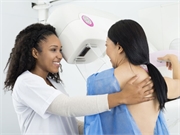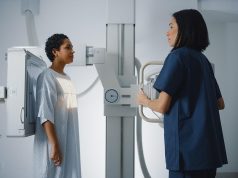Detection rates for additional cancers similar after digital mammography, digital breast tomosynthesis
WEDNESDAY, Nov. 20, 2019 (HealthDay News) — There is no significant difference in breast cancer detection rates with dense breast ultrasound screening following digital mammography (DM) versus digital breast tomosynthesis (DBT), according to a study recently published in the American Journal of Roentgenology.
Elizabeth H. Dibble, M.D., of the Warren Alpert Medical School of Brown University and Rhode Island Hospital in Providence, and colleagues retrospectively examined a total of 3,183 dense breast ultrasound exams performed between Oct. 1, 2014, and Sept. 30, 2016. A total of 1,434 patients (45.1 percent) had a screening ultrasound performed after DM, and 1,668 (52.4 percent) had a screening ultrasound after undergoing DBT. One hundred twenty-two DM and DBT patients were advised to pursue either a biopsy or cyst aspiration (all Breast Imaging-Reporting and Data System assessments categories 4 or 5). Only 118 patients (96.7 percent) had biopsy or cyst aspiration results available for review.
The researchers found no significant difference in cancer detection rates between types of screening methods used. Among the 36 biopsies or aspirations performed after DM, 30 (83.3 percent) were benign and six (16.7 percent) were found to be malignant; the additional cancer detection rate by ultrasound after DM was 3.5 per 1,000 women screened. Of the 82 biopsies or aspirations performed after DBT, 71 (86.6 percent) were benign and 11 (13.4 percent) were malignant; the additional cancer detection rate by ultrasound after DBT was 3.0 per 1,000 women screened.
“Knowing that the cancer yield of screening ultrasound is similar after DBT versus DM may help inform clinical practice, because questions abound about whether DBT is sufficient screening for women with dense breast tissue,” the authors write.
One author is an employee of Lifespan Biostatistics Core.
Copyright © 2019 HealthDay. All rights reserved.








